BoatTEST.com’s Test Numbers: What Do They Mean?
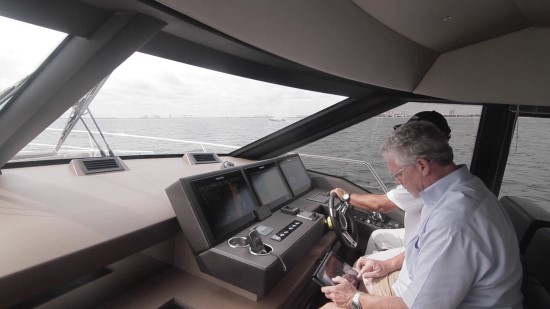
from boat to boat.
The Test Runs
Conducting performance tests on boats involves a lot of variables. There are tides, winds, waves, hot days, cold days, boats loaded with fuel, those almost empty, clean bottoms, dirty bottoms… all of which act on a vessel differently. And since there’s no known method of controlling any of these parameters this side of the Old Testament, we need to account for as many of the variables as possible. At BoatTEST.com, we do this in two ways.
First, we try our best to find areas where we can make long runs. Constant changes of course and heading only serve to slow the boat down, and make the job of compensating for wind and current complex. We determine the direction of the current and try to run into the teeth of it.
Second, we then make a second run in the opposite direction. This serves to eliminate the effects of the current and wind on the speed, and we then average out the two speeds for a final result. Now, additionally, where the first run was from idle on up to wide open throttle (WOT), the second run is also run opposite from an operational standpoint starting first at WOT and reducing that speed incrementally down to idle.
This not only eliminates the vagaries created from the flow of water, but also keeps the boat operating at the same speeds in the same areas. That makes things as equal as we can get them. But the testing conditions are rarely perfect. That is why we characterize our tests as being in “real-world” conditions.
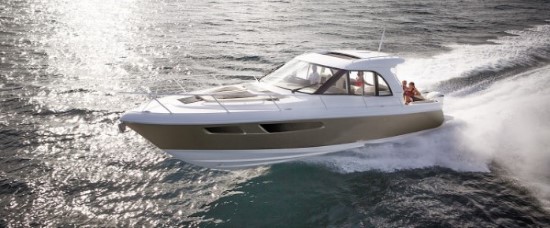
Consumer Caveat. We test the boats that are given to us and have no control over the condition of the boat, its bottom, props, or how much fuel is aboard. Boats are very weight sensitive. A boat with a light load of fuel will perform better than one that has a full load. Boats tested on a cool day will perform better than they will on a hot, humid day. Boats will perform better at sea level than they will at 1,000 ft. of altitude. BoatTEST.com always describes the test conditions, and this is important information that consumers should check when reading test data.
The Time to Plane
Planing time is another area where we strive for consistency, but the problem is that with different hulls, and different bottom configurations, boats plane differently from one another. Is there a flat running surface at the stern? Is there a consistent deadrise from the keel to the chines? All of this makes a difference.
When does it plane? Plus, the definition of exactly when a boat reaches planing speed is also subject to interpretation. Is it when the bow rises and peaks? Is it when it starts to come down? Is it when it’s all the way down? Every one of those parameters is subject to an individual’s perspective. Is there a wave involved when it comes up? When a bow comes down from that initial acceleration, there’s a bounce effect before it settles, so when is it down? At the bottom of that bounce, before it?
Each manufacturer has its own idea of when a boat reaches its planing speed. For BoatTEST.com, we’ve researched the methodology and arrived at one equalizer that we have adopted as the standard…. Planing speed is that speed at which the rooster tail is formed. For every boat, once the hull is on top of the water, that rooster tail becomes present, whether the bow is still coming down or not. The additional speed and momentum are what brings that bow down.
When waiting for the bow to come down before noting planing speed, there will be a one-to-two second delay, generally, as compared with our procedure.

Which one reached it first?
But all boats don’t necessarily plane. Certainly, displacement trawlers will never reach planing speed. They will achieve “hull speed,” which is a speed at which the wavelength of the boat's bow wave is equal to the boat’s length. The boat will seemingly be trapped in that trough of its own creation and that’s all she has to give. More power just burns more fuel as it pushes harder against that bow wave. A planing hull accelerates over that wave, gets on top of the water, and cruises off. The displacement hull always stays in the water, rather than on top of it.
Semi-displacement vessels, which includes many modern motoryachts, rise in the water, which reduces wetted surface, but they don’t actually plane, and they burn a lot of fuel in the process.
Another case in point is the pontoon boat. These boats are on top of the water, even at rest. Accelerating just increases the speed, but doesn’t necessarily raise the tubes higher in the water. They stay level (all things being equal) during acceleration and therefore have no real planing speed, although they do exhibit the speed characteristics. For these reasons, we don’t report planing speed for these types of boats.
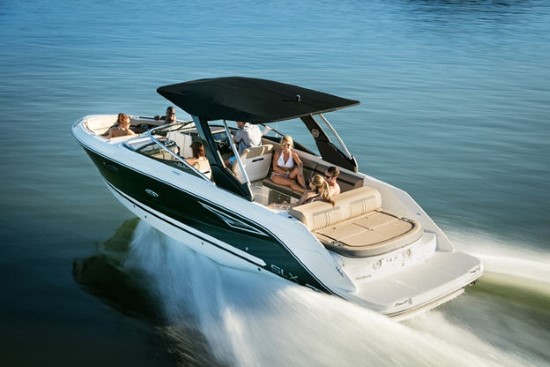
increases fuel consumption.
Why are Builder Performance Numbers Better than BoatTEST.com’s?
Many reasons. First, atmospheric conditions might be significantly different. Ambient temperature, humidity, elevation, are just
a few of the obvious reasons. So is weight. Boats are very weight sensitive, particularly small ones. BoatTEST.com always has at least two people aboard for a test, but we do not control the amount of fuel aboard -- the builder supplies that.
Ideal Conditions. Builders and engine manufacturers’ tests are typically more controlled. They will generally test in flat, calm water. They might wait for a cool day. They make sure that the props are in perfect condition. They always make sure the bottom is clean -- which is probably the single most important thing they can do after reducing weight. Each builder has its own procedures, and they run the gamut from rigorous to not so much.
All Engines are not the Same. Please recall that the internal combustion engine was invented in the 1800s. Even today, even the engines built in the most modern facilities with the best machine tools, are not built to the tolerances that we have come to expect of our computers and smartphones. That is why the Society of Automotive Engineers (SAE) allows engine makers to have a 10% tolerance between the rated/advertised horsepower and what each engine actually produces. Most engine makers give as a range the top rpm an engine can turn a tolerance of from 100 to 1000 rpm.
It is not uncommon for BoatTEST.com to test a boat which has engines that can turn the rpm that a builder’s test boat could. And, sometimes, the props are not exactly the same.
We can say that it is rare that our test numbers are better than those provided by the builder or the engine manufacturer. This doesn’t mean that they have fudged the numbers; it just means the conditions were different. We have to record the numbers we get on test day on the boat we are given, and can’t wait for ideal conditions. And, we don’t clean bottoms.
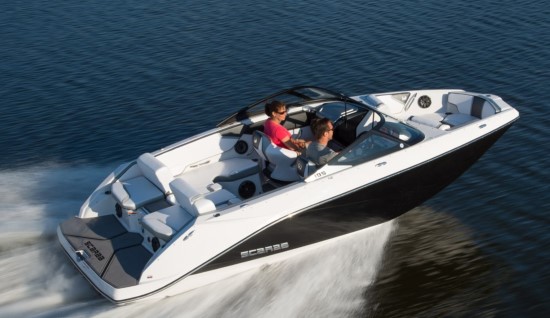
BoatTEST.com Tests are Real World
We think that our tests are generally what consumers should expect when they buy a boat we have tested. We test boats that have been sitting and may have bottom growth or props may have been dinged. When we schedule a test, we do it in any weather, and have tested in blistering heat, wind, snow, sleet, and gloom of twilight… yes, at one time or another, in all of those conditions.
What you see on camera has little to do with the actual test. That’s for the camera runs, another matter entirely. Why? Because we can’t film in the same choppy conditions that we may be testing in. The camera doesn’t need the long runs of the test area, but it does need calmer conditions to get the steady shots. Big difference between the two. But the point is, we test in real-world conditions and that is why our numbers are so sought after.
A Look at the Numbers
Once we get the boat moving, and record the speed and fuel burn, a trend immediately develops. A trend where, for the most part, more power equals more speed and more fuel burn. Want to burn just a little fuel? Go slow. Want to burn a lot of fuel? Go fast. This can easily be seen when we put it into a graph.

The graph is a good device to find if there are any anomalies as power is applied. For example, if the red line (gph) crosses the blue line (mph) it means that more fuel is being consumed without a commensurate increase in speed. This often occurs when a boat is trying to get on plane put is not quite there yet. That is a place to avoid. But interpreting that graph is problematic for most. Much more user friendly is the written format of the test results.
The Written Version
Here, we can see the black and white results for the same boat, and it is much more telling. Most people immediately look for the top speed. But this is actually not a particularly useful number, as very few people run their boats at top speed for more than a couple of minutes -- unless they own performance boats.
More important are realistic cruising speeds. Typically, there is a range of speeds for each boat that are a trade-off among speed, comfort, and fuel consumption. It is in that range that most boat owners should look.
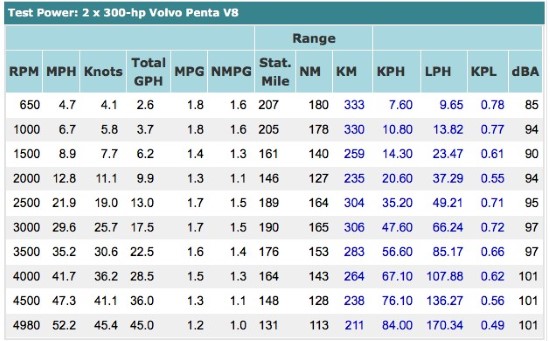
Best Cruise
Here’s where the rubber meets the road, so to speak. No one without sails will spend all day cruising along at 4.7 mph. Not even a long-range trawler is piloted by anyone that sadistic. So, what we need to see is the best economic cruise for our boat at planing speed… where we all run our boats.
For best cruise, we look at where the range numbers drop, and then come up again. For our example above, that happens between 2000 and 2500 rpm. That is where the boat reaches planing speed and gets on top of the water. But it still needs more speed to be more efficient. Operating right at planing speed still has the boat feeling the effects of drag from the water and a bow high attitude.
As power is added, the hull levels out and skims along the surface of the water much more efficiently. There comes a point at this performance attitude where the boat will go the farthest distance forward for the least amount of fuel burned. That is its best cruise, or more properly put, it’s best economic cruise. For the example above, that happens right at 3000 rpm, where the range numbers come up, peak at 190, and then start to drop back down again.
This can be further verified by looking at the mpg figures, which also peak at that rpm level.
Accelerating beyond the best economic cruise thus burns more fuel, and reduces the range of the boat. Of course, it’s more fun, but that’s another matter entirely.
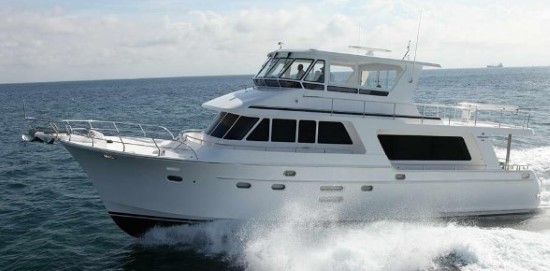
What about the Semi-Displacement hull?
Remember when we talked about the displacement hull that can only go so fast, and that’s it? A semi-displacement boat can operate as both a long-distance cruiser in displacement mode, or a faster semi-planing cruiser. So, depending on how far one wants to go, there are various “best cruise” speeds.
Let’s take a look at the numbers for just such a yacht…

With this yacht, we can operate as a long-distance cruiser at 1000 rpm and 9.7 knots. That will take us over 1,800 nm at a speed that is still faster than most cruising trawlers. That’s an inviting figure considering Ft. Lauderdale to Bermuda is 935 nm. Once we get there, we can open up the throttles and cruise efficiently at anywhere from 1500 rpm to WOT as there’s little change to the efficiency at that range, all staying at 0.5 nautical miles per gallon. That’s why these boats are so attractive to the cruising set. But they don’t actually plane.
Because these numbers are rounded to the nearest single digit, you must look to the range column to find out at which speed and rpm the boat is actually most fuel efficient.
But what if you haven’t tested my boat?
You can still make comparisons easily enough to provide a baseline for your boat. Simply use our search engine to find a boat in the same size range. Then look for one that comes in at around the same weight. Finally, look for the horsepower that is closest to yours. The results will not be exactly the same as your boat, but close enough for comparison. If the numbers are way off, it’s time to start asking why. Is your hull bottom growing a beard from lack of use? Are your fuel filters clogged? Are you burning dirty fuel?
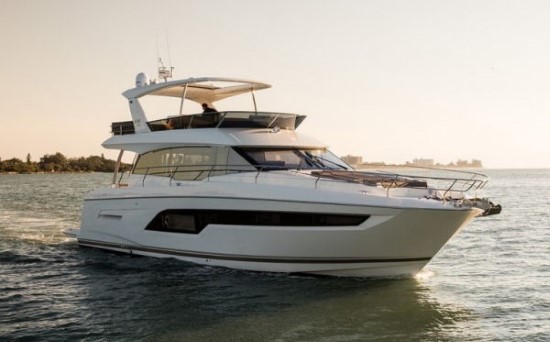
Bottom Line
Whiz Kids. Depending on what type and size boat you own or plan to buy, different numbers will be the key to choosing the right one. For people just concerned about having the fastest sport boat on the lake, of course, it is top speed.
Budgeting. But, if you are interested in figuring how much you should budget for a season of fuel consumption, you need to look at best cruise. Do you think in terms of hours of boating or miles traveled? The gph and mpg numbers will be the most helpful.
Trip Planning. When planning a long cruise, it is good to know how far you can get on a tank of fuel in order to plan your fuel stops. Then you will know how fast to go and when it is the best time to stop for fuel.
Boat Buying. All boats are not the same, and in some cases they are quite different, even in the same class. It is good to know which boat will be the least costly to operate, which one can hold itself comfortably on plane without excessive rpm, which one has the most economical best cruise, and which one has the fastest best cruise.
Distance cruisers with displacement and semi-displacement vessels will want to know how far they can go at a certain speed. For example, owners of large motoryachts that are capable of 20 knots usually don’t want to run their boats there for long. They are more interested in range at 10 knots.
Underpowering is a common consumer trap, as builders try to make their boats as inexpensive as possible, and so they install as standard an engine that operates best with only a couple of people aboard and cannot handle much strenuous work, such as towing wakeboarders. The key here is to look at the rpm to see how hard the engine has to work to keep its best cruise speed. Look at the fuel load and weather conditions. The way for boaters to know if a boat is right for them is to see how it functions in the conditions in which they do their boating. That’s the real-world test.